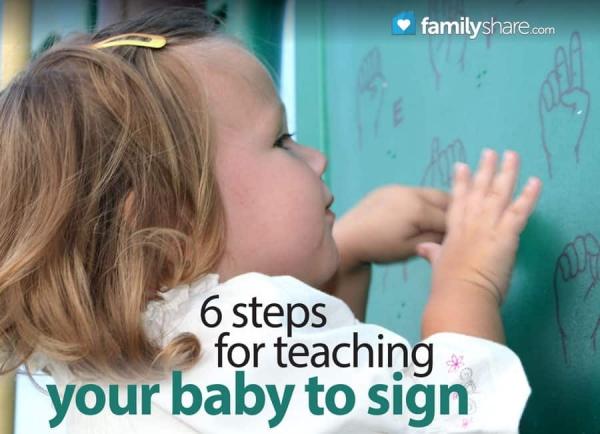
Trying to figure out your baby's needs is challenging. Some children can't fully communicate with words until age 2 or older. Parents are encouraged to try and recognize needs by physical cues and cries, but being a baby whisperer is tough. If you want help communicating with your baby, try baby signs. It's easier than you think - just follow these 6 steps.
1. Learn the signs yourself
A few weeks before you want to start teaching your baby signs, learn some yourself. I suggest starting with signs your young baby will use. These include "more,"� "all done,"� "milk,"� "mommy,"� "eat,"� "book,"� "sleep"� and "up."� You can check out a few books at your local library (geared towards adults or children), get DVDs like the Signing Time series, or look for online examples. Be sure to find materials that are geared specifically towards babies. Baby sign is simplified so the smallest children can do it.
2. Start early
Your baby will get the most benefit from signing if they can use signs well before they begin speaking. I start signing to my children when they start eating solid foods, which is around six months. As you feed them, ask if they want "more"� and use the sign. Don't introduce too many signs to your young baby. Use one or two for a week or two, and then add in a few more. Make sure to say the word aloud as you use the sign and try to use it several times. If you start teaching sign to an older baby, they will pick up the signs much more quickly, perhaps in a day or two.
3. Be consistent
Make sign language part of interacting with your baby several times a day. Encourage your spouse, partner or other caregivers to use the signs. If your baby has older siblings, enlist their help too. A conversation at meal time might go something like this: "Do you want a drink? Would you like milk? Here is your milk. You can have a drink. Are you all done? I will take the milk. Thank you."� The signed words are "drink,"� "milk,"� "all done"� and "thank you."�
4. Be patient
Don't expect your 7 month-old to be signing in a week or two. My babies usually started signing back around 8 or 9 months. Babies might not make the signs exactly as you demonstrate them. "More"� can be signed with just pointer fingers touching, and "thank you"� might be touching the fingers anywhere near the mouth and then putting them down. Babies understand much more than they can vocalize, so be patient as your child learns signs. If you think they are signing, ask them and use the sign and word yourself.
5. Follow baby's lead
If your baby doesn't seem interested in signing, back off and try again in a few weeks. Conversely, a child who enjoys signing might like to learn more signs well beyond the basics. If this is the case facilitate his interest by learning and introducing new signs. Think of things he is interested in, like "ball"� or "dog."�
6. Reinforce and learn together
If you don't use signs consistently, your baby won't either. Check out board books from the library and read and sign together. This is a fun way to learn new signs. I have an app that teaches simple baby signs. Even though my daughter speaks well now, she will still use the sign for "more"� when she really, really wants something.
Signing is simple and convenient. Open up a new way of communication with your baby by teaching baby signs. You'll have less fussing and wondering, "What do you need?"� Your baby can easily tell you with the use of signs.

